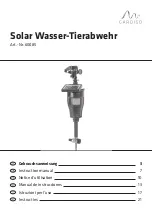
23
Appendix
Handling the display unit
• When the LCD panel is subjected to direct sun-
light for a long period of time, it will become
very hot resulting in possible damage to the
LCD screen. When not using this unit, close
the LCD panel and avoid exposing it to direct
sunlight as much as possible.
• The display unit should be used within the tem-
perature ranges shown below.
• Operating temperature range: –14 to +122 °F
• Storage temperature range: –4 to +176 °F
• Do not use the display unit at temperatures
higher or lower than the operating tempera-
ture range because the display unit may not
operate normally and the display unit can be
damaged.
• The LCD screen is exposed in order to increase
its visibility within the vehicle. Please do not
press strongly on it as this may damage it.
• Do not place anything on the LCD panel when
it is deployed. Also, do not attempt to carry out
angle adjustment, or open/close the LCD panel
by hand. Applying strong force to the LCD
panel may damage it.
• Do not push the LCD screen with much force
as this may scratch it.
• Never touch the LCD screen with anything
besides your finger when operating the Touch
Panel functions. The LCD screen can scratch
easily.
• Be careful not to place anything between the
LCD panel and the main body when the LCD
panel is opening or closing. If an object gets
between the LCD panel and main body, the
LCD panel may stop working.
• Be careful of fingers, long hair, and loose
articles of clothing which could possibly
get caught between the LCD panel and the
main body and cause serious injury.
Liquid crystal display (LCD)
screen
• If the LCD panel is near the vent of an air con-
ditioner when it is opened, make sure that air
from the air conditioner is not blowing on it.
Heat from the heater may break the LCD
screen, and cool air from the cooler may cause
moisture to form inside the display unit result-
ing in possible damage. Also, if the LCD panel
is cooled down by the cooler, the LCD screen
may become dark, or the life span of the small
fluorescent tube used inside the LCD panel
may be shortened.
• Small black dots or white dots (bright dots)
may appear on the LCD screen. These are due
to the characteristics of the LCD screen and do
not indicate a problem with the display unit.
• At low temperatures, the LCD screen may be
dark for a while after the power is turned on.
• The LCD screen will be difficult to see if it is
exposed to direct sunlight.
• When using a portable phone, keep the
antenna of the portable phone away from the
display unit to prevent disruption of the video
by the appearance of spots, colored stripes,
etc.
Keeping the LCD screen in good
condition
• When removing dust from the LCD screen or
cleaning the LCD screen, first turn the system
power off, then wipe with the
supplied cloth
.
• When wiping the LCD screen, take care not to
scratch the surface. Do not use harsh or abra-
sive chemical cleaners.
Small fluorescent tube
• A small fluorescent tube is used inside the dis-
play to illuminate the LCD screen.
— The fluorescent tube should last for approx-
imately 10,000 hours, depending on operat-
ing conditions. (Using the display unit at
low temperatures reduces the service life of
the fluorescent tube.)
— When the fluorescent tube reaches the end
of its useful life, the LCD screen will be dark
and the image will no longer be projected. If
this happens, consult your dealer or the
nearest authorized PIONEER Service Sta-
tion.
Содержание A-GPS Dog Locator
Страница 1: ...Hardware Manual DVD MULTIMEDIA AV NAVIGATION SERVER AVIC N1 ENGLISH ...
Страница 2: ......
Страница 20: ...18 Chapter 1 How to Use Navigation Unit and Names of the Parts ...




































